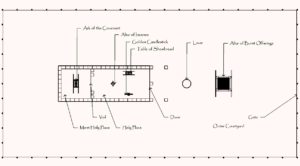
The hit song Wichita Lineman was recorded by Glen Campbell in 1968, a song that manages to squeeze a lifetime of emotion into just three minutes. Many have long speculated that behind its only 16 lines there was a hidden deeper meaning. Many of Campbell’s songs were written by other composers, in this case Jimmy Webb, who later said the song was unfinished and he never intended it to be released or recorded in its form.
There are more miracles in the Book of Mark than any other gospel account even though it is the shortest of the four. There is no genealogy in his account, he focuses on Jesus as Servant, it is the action gospel, it is an account of Christ’s power in action and it was written essentially to the Romans, a gospel for the Gentiles. How do we know? Mark’s purpose was to write down the Gospel just as Peter presented it to the Romans. Six times he translates Aramaic expressions into Greek, twice he explains Jewish customs, and only quotes the Old Testament once. He uses action words (i.e. “immediately, straightway, forthwith, etc.”) and verbs are in present tense 150 times.
“For even the Son of man came not to be ministered unto, but to minister, and to give his life a ransom for many.” (Mark 10:45)
He sometimes shares details that are not seen in the other gospel accounts. John was his Jewish name, Mark his Latin surname, otherwise known as “John Mark.” He was the son of a wealthy woman (Acts 12:12) and many believe he was in fact the “rich young ruler” found in Mark 10:17-22. For by his account alone, “And Jesus looking upon him loved him…” hinting at the possibility that young John Mark may have been that rich young man.
In the fifth chapter of Mark there are two beautiful miracles that Jesus performs but there are a few details that Mark provides that the other two accounts do not (Matthew 9:18-26; Luke 8:40-56). Do these details imply a deeper meaning?
Returning from the Decapolis (Gentile country), Jesus arrived back on the west side of the Sea of Galilee when he was approached by a man named Jairus, a ruler or chief elder of the local synagogue. “And, behold, there came a man named Jairus, and he was a ruler of the synagogue; and he fell down at Jesus’ feet, and besought him that he would come into his house (Luke 8:41). It is remarkable that a ruler of a synagogue (in what may have been Capernaum) would come to Jesus and this reflects that people in Galilee were beginning to acknowledge who Jesus was, that He is indeed the Messiah. Jairus’s daughter lays dying at his home and he pleads for her life. “….My little daughter lieth at the point of death: I pray thee, come and lay thy hands on her, that she may be healed; and she shall live” (Mark 5:23).
Luke estimates (8:42) and Mark confirms (5:42) that Jairus’s daughter was 12 years old. Why did the Holy Spirit include this detail?
Jesus responded immediately and went with Jairus, accompanied by his disciples and a large crowd or procession of people followed. In route, two things occurred. First, a story within the story unfolds. A woman who had suffered from constant bleeding for twelve years pressed into the procession and touched the hem of Jesus’ garment for the purpose of being healed.
“And a certain woman, which had an issue of blood twelve years, And had suffered many things of many physicians, and had spent all that she had, and was nothing bettered, but rather grew worse” (Mark 5:25-26)
It is interesting that the Holy Spirit imparts the suffering of this woman had gone for twelve years. Was it a rhetorical device to suggest a link between the two stories?
“When she had heard of Jesus, came in the press behind, and touched his garment. For she said, If I may touch but his clothes, I shall be whole. And straightway the fountain of her blood was dried up; and she felt in her body that she was healed of that plague” (Mark 5:27-29).
At this point, Jesus knew that power had flowed out from him and turning asks, “Who touched my clothes? (verse 30) And he looked round about to see her that had done this thing” (v.31). His disciples seemed incredulous at the request given the throng around him. Why did Jesus do this? Was it to humiliate the person who did this?
With fear and trembling the woman came forward and fell down before him and told Jesus what she had done. “And he said unto her, ‘Daughter, your faith has healed you. Go in peace and be freed from your suffering” (Mark 5:34). Instead of humiliating her, Jesus did two things, 1) He clears any possible misconceptions and confirms her healing, and 2) by doing so He explains that she didn’t “steal” a miracle from God but that it was her faith that healed her.
(And take note, it is the only time recorded in the Bible that Jesus bestows the name “Daughter” on anyone.)
And then suddenly, a second development: a servant from the home of Jairus arrives telling him that his daughter has died. Upon hearing this, Jesus turned to Jairus and said, “Be not afraid, only believe.” (Mark 5:36)
(In Hebrew, the name Jairus translates “God enlightens.”)
Amidst the mournful wailing, Jesus is met with scorn and laughter upon entering the home as if it is too late. Along with Peter, James, John the brother of James, and Jairus and his wife, Jesus enters the room, “And he took the damsel by the hand, and said unto her, Tal’-i-tha cu’-mi; which is, being interpreted, Damsel, I say unto thee, arise. And straightway the damsel arose, and walked; for she was of the age of twelve years” (Mark 5:41-42).
This is such a beautiful story, but what is the “linkage” you seem to imply by the two “twelve years” cited?
Consider first, Jairus’s daughter was 12 years old. So, she was born at the time this woman’s bleeding issue began. Coincidence?
Most Bibles depict the bleeding woman’s dilemma as a Jewish matter, and it was. A woman of Israel with an issue of blood (vaginal bleeding) would have had to remain “outside the camp,” ceremonially unclean (Leviticus 15:25-30). And for that matter, anyone who touched her would also be ceremonially unclean or defiled including her husband and children. It was terrible, the issue of blood makes one ceremonially unclean, anything/anyone she touched was ceremonially defiled (Leviticus 15:19-33; 18:19; 20:18). By the very Law, she would have become ostracized from all society and therefore divorced from her husband. She would not have been allowed to enter a synagogue nor even approach a rabbi or ruler. Then how was she able to press into the procession? The Jews were very observant of these matters. The physical evidence alone would have exposed her. The disciples generally tried to manage the crowds around Jesus especially in travel, how then was she able to touch Jesus’ garment? Because she wasn’t a Jew, she was a Gentile!
As a Gentile, this woman knows that she could not have approached Jesus directly in any circumstance, and with her bleeding issue, it would have been impossible to approach Him in a synagogue and definitely not in a Jewish residence. The only time she could have obtained access as a Gentile woman is while Jesus was traveling by foot in procession. As a Jewish woman attempting to enjoin His traveling procession, she had no chance to join this crowd for she would have been quickly identified as lawfully persona non grata from a Levitical perspective and quickly turned away.
In his writings, the Christian historian Eusebius indicates the bleeding woman was a wealthy Gentile woman from Caesarea Philippi, an ancient Phoenician city, very non-Jewish then and inhabited by Greeks (today it is known as Banias). He supposedly wrote that her name was “Veronica.” In his Ecclesiastical History (Book 7, chapter 18), he wrote that, as was a customary Gentile practice, after being healed the woman built a statue of her kneeling before the Lord receiving the miracle healing and he had seen it himself years later at her residence. It is interesting to note that if in fact her name was Veronica, her Greek name is translated from “bere nike” which means “bringing victory.”
“Lo, I come: in the volume of the book it is written of me. (Psalm 40:7).
Thus, consider the “story within the story,”
Jesus Christ is on His way to raise from the dead a daughter of Zion, and along the way a Gentile woman is healed through her faith in Him.
Now, consider the prophetic implications of that statement.
And…
Hosea 6:2….revive “us”? (Israel) (2nd Peter 3:8)
Acts 15:13-18….”after this”? > (v.14)
Romans 11:25….”until” >one day a sum of totality will occur

